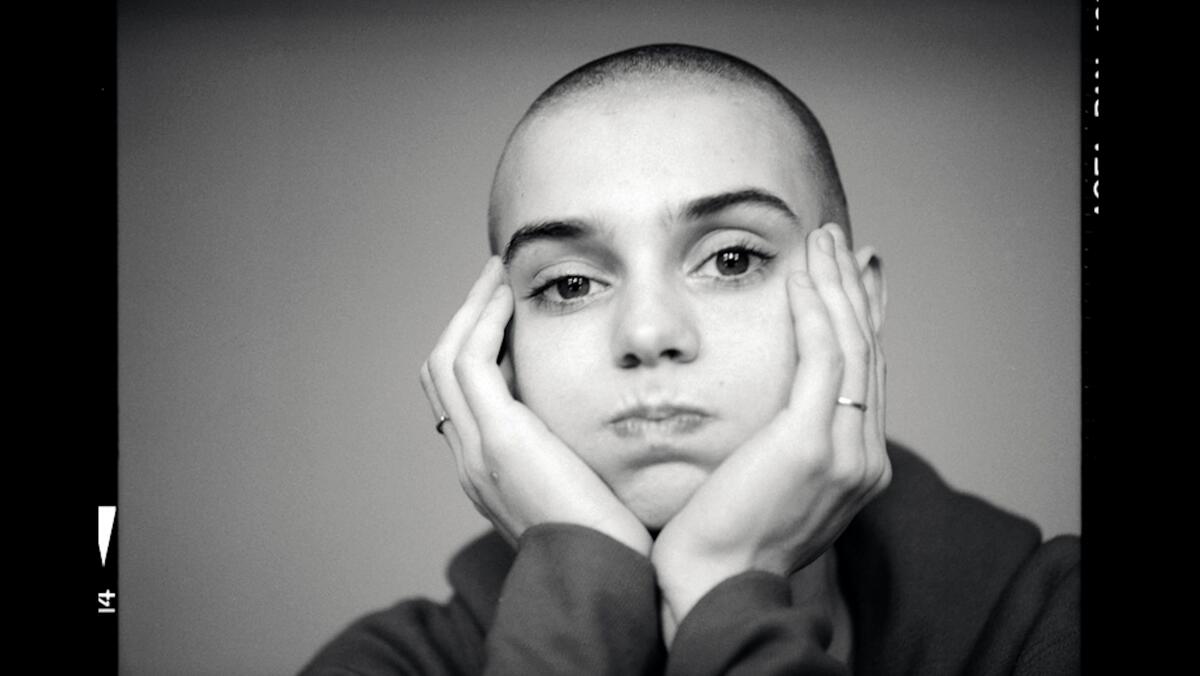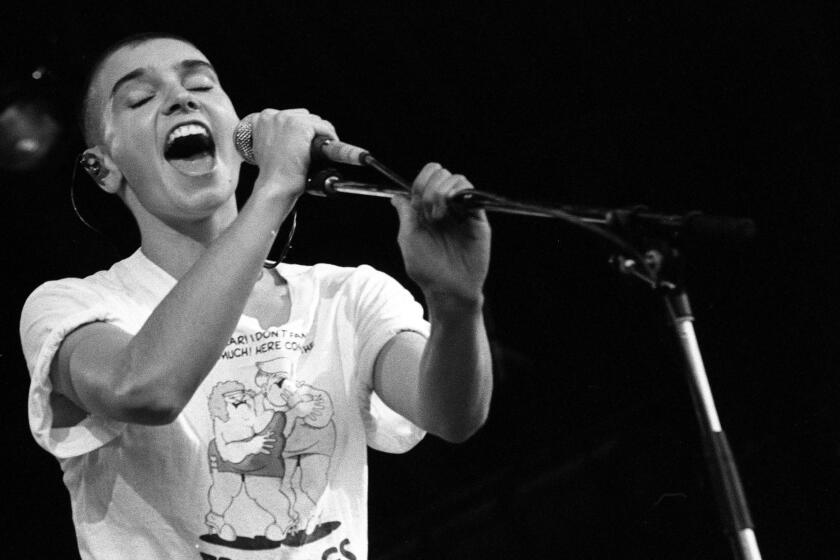My favorite Sinéad O’Connor album nearly ended her career

- Share via
Everyone in the world knows whose photo Sinéad O’Connor ripped up on “Saturday Night Live” in 1992. Hardly anybody recalls why she was there in the first place.
The Irish singer and songwriter, whose death at age 56 was announced Wednesday, famously nuked her career that night when she punctuated an a cappella performance of Bob Marley’s song “War” by tearing a picture of Pope John Paul II into shreds as an act of protest against the church’s sexual abuse of children.
But what had gotten O’Connor booked on “SNL” that October was actually its own form of professional self-immolation: the release just days earlier of her third studio album, “Am I Not Your Girl?,” a collection of old songs — standards, if we’re defining that term loosely — on which she was backed by an orchestra of several dozen players. (Before she sang “War” on “SNL,” she promoted the LP by doing a version of its “Success Has Made a Failure of Our Home,” a country hit in the early 1960s for Loretta Lynn.)
O’Connor was pilloried for her ‘SNL’ protest against the Catholic Church. But she never stopped speaking out against injustice and inspiring others to do the same.
I suppose I can understand why O’Connor’s team might have thought this idea might play. Two years before, Madonna had gone big band to double-platinum success with her album “I’m Breathless,” which accompanied her role as Breathless Mahoney in Warren Beatty’s Hollywood adaptation of “Dick Tracy.” Two years later, Tony Bennett would make a splashy commercial comeback with the Grammy-winning “MTV Unplugged,” on which he pulled from the same Great American Songbook that provided O’Connor with some of her repertoire.
But beyond its inclusion of Rodgers and Hart’s durable “Bewitched, Bothered and Bewildered,” “Am I Not Your Girl?” is a truly peculiar take on the standards-album concept, with far-flung material she selected according to her personal history of listening — these were songs that “inspired and comforted” her, she said — rather than any notion of joining a canonical hit parade.
And indeed it was no hit: Critics hated the album — “labored” and “cloying,” said Rolling Stone — while it climbed no higher than No. 27 on the Billboard 200 (compared to six straight weeks at No. 1 for its predecessor, 1990’s “I Do Not Want What I Haven’t Got”). Even the Grammys, which had showered nominations on O’Connor’s breakout smash, “Nothing Compares 2 U,” ignored “Am I Not Your Girl?” — perhaps because the singer had boycotted the 1991 ceremony, saying the awards show upheld “false and destructive materialistic values.”
A singer of rare power and finesse, O’Connor found fame with a brooding Prince song, then spent decades spanning styles and genres in search of emotional truths.
Here’s the thing, though: “Am I Not Your Girl?” — largely overlooked even now in remembrances of O’Connor’s life and work — is a brilliant showcase of her artistry, starting with the eclectic track list that foreshadowed her later explorations of reggae and Motown and traditional Irish music. She mixes lush stuff from Broadway and the movies (“Bewitched,” “Secret Love,” “Love Letters”) with the stark folk ballad “Scarlet Ribbons” and that Loretta Lynn tune and “Don’t Cry for Me Argentina,” from Andrew Lloyd Webber’s mid-’70s “Evita”; she winks at Betty Boop on “I Want to Be Loved By You,” then contemplates suicide on “Gloomy Sunday.” There are songs associated with Billie Holiday, Ella Fitzgerald and especially Peggy Lee, but no Cole Porter, no Jerome Kern, no Irving Berlin, no George Gershwin — the warhorses of the form, all left out in favor of a raunchy blues like “Why Don’t You Do Right?”

And her performances! That this natural songwriter was also a gifted interpreter should have surprised no one; “Nothing Compares 2 U,” of course, was a cover of a throwaway Prince song in which she found new emotional depth. Yet the range of vocal approaches she takes here is astounding: hushed and trembling in “Black Coffee,” haunted by memory in “Scarlet Ribbons,” vulgar and proud of it in “Why Don’t You Do Right?”
She brings so much yearning sensuality to “Bewitched, Bothered and Bewildered” — a tune you’d have thought had been squeezed dry long before she got to it — that you almost have to blush when she whisper-moans the line about worshiping the trousers that cling to him. And then there’s “Success” and “Argentina,” two very different songs about the wages of celebrity that she sings with a sense of drama bordering on desperation. The climax of “Success” in particular, with O’Connor practically sobbing as the orchestra blares around her, is brutal — all the more so given what we know was to come for her just after the album came out.
Speaking to The Times’ Robert Hilburn on the eve of its release, she said her rendition of the song was about “the way that desire for material success has been responsible for so much pain in the world,” drawing a line from England’s invasion of Ireland to the abuse she suffered as a child at her mother’s hands.
Quite a way to frame a big-band project that came out on the heels of Harry Connick Jr.’s swinging soundtrack from “When Harry Met Sally … .”
Does this forgotten treasure — my favorite of the 10 LPs O’Connor released during her life — leave any kind of legacy? I hear traces of its forlorn wit in Billie Eilish’s quieter ballads and of its queasy fascination with the Hollywood dream factory in music by Lana Del Rey (the latter of whom knows something about damaging appearances on “SNL”). But I suspect it lives on primarily as a footnote to a showbiz scandal — and as a shared secret among those of us who love it.
More to Read
The biggest entertainment stories
Get our big stories about Hollywood, film, television, music, arts, culture and more right in your inbox as soon as they publish.
You may occasionally receive promotional content from the Los Angeles Times.












